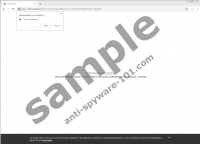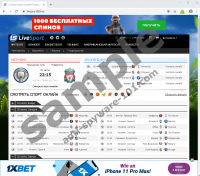Superpushoffer.club is an ad server that was designed to introduce people to promotional content. It is not clear what parties this server is associated with, and so it is not possible to know whose ads might be shown via it. This is an important thing to think about because if you cannot trust a service completely, you should not use it at all. Of course, the service provided by this ad server is not exactly built for regular people. It is built for advertisers, and so do not think that anyone cares about your virtual security. Could it be jeopardized if you interacted with the advertisements presented to you? That is a possibility. If you face one ad, and if you choose to ignore it, perhaps you are safe. However, if you have enabled notifications by the ad server, ignoring the suspicious ads might become impossible. Needless to say, we recommend deleting Superpushoffer.club notifications, and if you want to learn how to do it, keep reading. Read more »
Threats - Page 9 category archyve:
Thewowfeed.com
You do not want to have to deal with advertisements presented via Thewowfeed.com because this ad server is unlikely to offer anything useful, transparent, or trustworthy. Instead, it is likely to promote the services and products of parties that cannot be trusted, and that is why we suggest exiting the page that presents such ads as soon as possible. Unfortunately, some people are tricked into enabling notifications that are delivered by the ad server. If that is set up, ads can flood randomly, even when you are visiting trustworthy websites. Of course, you might be able to delete the pop-up ads by closing them, but they would reappear. Ignoring them might be difficult as well, given their distracting nature. Without a doubt, interacting with these ads is the worst choice. The good news is that you can remove Thewowfeed.com ads without having to put in too much effort. If you run Firefox, Chrome, or Edge, we can show you how to get rid of the annoying ads with the guides below. If you need a guide for a different browser, let us know. Read more »
What is Click To Watch Live
Researchers say that What is Click To Watch Live is an adware server. In other words, it is a website that can show notifications with advertisements from multiple third parties. However, to display such content, the website first needs to get your permission, and the way it does it might make users give the consent for showing notifications without realizing it. Further, in this article, we talk about how users could come across this adware server, how they might be asked to give permission to show notifications, and why agreeing to receive such content might be a bad idea. Also, we explain how users can get rid of What is Click To Watch Live notifications if they end up not liking them. For step by step instructions, we recommend checking the deletion guide placed below this article. Read more »
Altgreating.club
Have you been redirected to Altgreating.club? Did this domain show some random advertisement? Perhaps your browser’s settings were modified to allow commercial notifications. This happened with your permission, but perhaps you didn’t notice the exact moment the changes were performed. Fear not, for you can get rid of anything associated with Altgreating.club. Just scroll down to the bottom, and you will find guidelines that will help you restore your browser to default. You should also run a full system scan with the security tool of your choice because you are bound to have more unwanted programs installed. Read more »
Livesport.ws
Browsing the web is not always a safe activity, especially if you come across Livesport.ws, an adware server that has been found to redirect people to livesport365.ws. What is wrong with redirecting? If it is unauthorized, people might be redirected against their will. Furthermore, the websites to which the server might redirect to could be unreliable. That appears to be the case with livesport365.ws. Although this website might offer useful information to some of its visitors regarding sports and results, it was found by our Anti-Spyware-101.com research team that it could present links that lead to unreliable websites as well. In one case, the website offered a link to an illegal gambling website, access to which was automatically blocked by the web browser. Unfortunately, not all web browsers have such security mechanisms, and so interacting with the content shown on the website could, potentially, be risky. Of course, in this report, we focus on showing you how to remove Livesport.ws components. Read more »
GraceWire
GraceWire is a threat that uses stealth techniques to slither into Windows operating systems so that it could collect sensitive data without notice. Our Anti-Spyware-101.com research team identifies this Trojan as an info-stealer. Since the functionality of this malware appears to be quite limited, there is a high chance that it could run along with other malicious threats. The Trojan belongs to the Evil Corp group, also known as the Dudear group, and it is well-known for other infections. We talk more about them further in the report. The targets of this group are unknown, and it is possible that it does not conduct targeted attacks at all. Perhaps the group is taking advantage of anyone it comes across. If we learn anything new about this malware, we will surely update this report as soon as possible. If you continue reading, you will learn how this infection spreads, which, hopefully, will help you keep it away from your operating system. We also touch on the removal of GraceWire, which, of course, is crucial. Read more »
Nlah Ransomware
If Nlah Ransomware invades your system successfully, it messes with the data of your personal files, and also attaches the “.nlah” extension to mark them. The infection uses the method of encryption to ensure that you cannot read your own files, and that can push you into a very unfortunate situation. Our research team has thoroughly inspected this malicious file-encrypting malware, and we can guarantee that it is a clone of Usam Ransomware, Kuus Ransomware, Maas Ransomware, Sqpc Ransomware, and many other infections from the STOP Ransomware family. Quite likely, the same attacker is responsible for all, or at least most, of them, and there is proof for this conclusion. All in all, whether we are dealing with one attacker or hundreds of them, your system is just as vulnerable, and your files are just as locked. Sadly, it is not possible to recover the files by removing Nlah Ransomware. Nonetheless, this infection must be deleted ASAP, and we can show you how to do it. Read more »
Usam Ransomware
Windows users beware, Usam Ransomware is on the loose. Unprotected systems with unpatched vulnerabilities are the ones that are likely to be affected by this dangerous threat, but note that it might not need to use vulnerabilities or secret backdoors to slither in. It might simply trick you into executing it yourself. This could be done by hiding the launcher of the infection within spam emails or bundled downloaders. In fact, cybercriminals have many different ways, in which malware can be spread, and it is your responsibility to ensure that your own operating system is an impenetrable fortress. Unfortunately, to some users, that is easier said than done. Anti-Spyware-101.com researchers know very well what happens when ransomware slithers into an operating system. If the threat is caught and removed in time, disaster can be avoided. If the threat encrypts files first, victims might be enveloped into a scam. Keep reading to learn more about this scam as well as how to delete Usam Ransomware. Read more »
Kuus Ransomware
If your computer cannot open your files and they have .kuus extension, your system might have been infected by a threat called Kuus Ransomware. It is a malicious file-encrypting application that uses a robust encryption algorithm to lock files that could be valuable. Afterward, the malware drops a ransom note asking to pay ransom if you want to get decryption tools that could unlock all files. The hackers may reassure you that you will get the promised tools, but, in reality, there are no guarantees that you will receive them. Therefore, we advise you to think carefully if you really want to deal with cybercriminals. Until you decide that you may want to learn more about the malware, in which case, we invite you to read the rest of this article. A bit below it, you should see our deletion instructions that show how you might be able to erase Kuus Ransomware manually. Read more »
Tabe Ransomware
Tabe Ransomware is a dangerous file-encrypting threat that can restart with the operating system. It is bad news, because there is a chance that every time it restarts it may start encrypting files again. Of course, such functionality might not affect the files that were already encrypted, but it could put new data at risk. If you want to know more about how this vicious threat works, where it comes from, and how it can be erased, we encourage you to read the rest of this article. Also, we can offer the instructions available at the end of this text. They show how users could erase Tabe Ransomware manually. This task could be challenging even if you follow our instructions carefully, in which case, we recommend using a legitimate antimalware tool that would make the removal process faster and easier. Read more »






